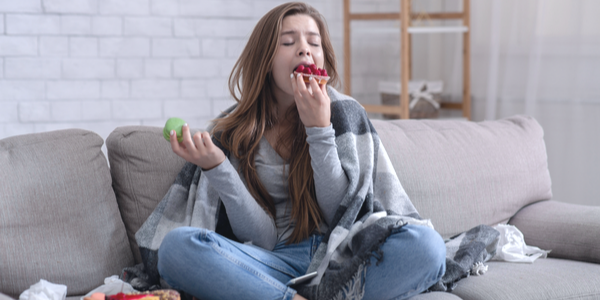
"Mmmm, a donut sounds great right about now!" "Ooooh, I could go for a juicy steak..." "A gooey brownie would be the cherry on top of this delectable dinner!"
Otherwise known as cravings, these desires are typically considered pesky ploys to derail health goals. However, is that all a craving represents? Hardly.
Discover the different reasons a craving may strike and how to best control hunger cravings while still prioritizing health.
Hunger vs Cravings
Most everyone has experienced a deep craving for a specific food or meal at one time or another. Perhaps, the same food cravings strike around the same time each day.
While food cravings are completely normal, not all are created equal and different types may indicate certain physiological or emotional states.
Hunger
In a sense, biological hunger is the strongest type of craving. This physiological craving for a meal often signifies that the body is low on energy stores. Symptoms like a growling stomach, poor concentration, and irritability signal that food consumption is imminent for energy production.
This kind of craving usually is not limited to one type of meal or food and instead feels like a strong desire for hearty food. Oftentimes, people experiencing true hunger desire food of substance such as a high protein steak or burger - foods with savory or umami flavor that will provide lasting nourishment.
Interestingly, people in the midst of this craving will often deny snacks and sweets, subconsciously understanding that those kinds of foods are not going to quench their wholesome meal craving. Bodies are pretty smart, and a genuine hunger craving is simply helping you survive.
Common physical causes of increased food cravings include:
• Increased or different style of physical activity
• Poor hydration
• Lack of sleep
• Low fiber, protein, and/or healthy fat diet
• PMS
• Pregnancy and lactation
• Increased ghrelin (hunger hormone) and leptin (fullness hormone that functions like insulin, and increased circulating amounts represent resistance to the hormone)
Emotional Cravings
On the other hand, emotional food cravings are not necessarily trying to keep us alive. It can certainly feel like the end of the world not being able to fulfill a craving, but the body will almost definitely persevere.
Emotional food cravings can be difficult to ignore and usually manifest as an urgent, intense yearning for a specific ingredient, food, or meal. Typically of a negative nature, different situations or groups of emotions can trigger them.
Alone, mental stress can cause a surge secretion of cortisol, which has been linked to increased appetite, emotional cravings, and a higher likelihood of binge-eating behaviors. Additionally, negative emotions like anger, sadness, frustration, disappointment, or boredom can lead to cravings for comfort foods or sweets as a way to essentially mitigate the negativity because these kinds of foods trigger pleasure pathways.
Positive emotions, however, can also provoke food cravings. Celebrating a birthday or a big win or the end of a hard-worked week can also generate the desire to feast on delicious treats or gourmet meals. In fact, eating context can regularly spur cravings, where the brain autonomously associates specific situations or feelings with eating specific foods.
For example, birthday parties are synonymous with cake, finishing a race is associated with drinking beer and champagne, and 4:00 pm on Friday may be linked with charcuterie boards and happy hour… Or five.
In the above instances, the food cravings are ingrained associations. Sometimes, you as a person may not even truly desire the associated food, but you participate willingly because it is imprinted in your psyche.
Finally, some evidence suggests that people who are more impulsive or addictive in nature have a higher incidence of experiencing more food cravings, especially for sweet treats. This is likely because those with high impulsivity and/or addictive natures are seeking the pleasure pathway. High sugar foods trigger the same pleasure pathways as drugs and other risky behaviors like gambling and jumping out of planes.
Other Cravings
Although controversial, some cravings may be triggered by nutrient insufficiency and/or a higher need for a specific nutrient. For example, females need more magnesium and iron during their period, which can trigger cravings for foods high in those nutrients, like dark chocolate!
If sodium status is low, one might crave salty snacks and if a 5K race is approaching, potassium-rich foods could pop into the mind. Again, the body is wildly intelligent and wants to be as prepared and nourished as possible.
Yet, it is important to note that there is not much science around this theory. Intense cravings for calorically dense but nutritionally void foods rarely signify a true nutrient deficiency and are likely more of an emotional craving. However, if you tend to be lower in one nutrient and often crave food high in that vitamin or mineral, that is a better sign that deficiency is the provocation.
Finally, some people experience cravings for non-food items – a condition called pica. This commonly presents in children or pregnant women and the cravings can be for any non-food item although ice, laundry detergent, cotton balls, dirt, or sand are reported frequently.
Some research also suggests people with pica are low in iron, calcium, and/or zinc. Cravings should surpass when the nutrients are replenished, but if they do not, further medical advice is warranted.
How to Control Cravings That Are Physical
Managing or stopping food cravings revolves around the cause of the craving. Most physical cravings should be "controlled" by feeding your body nutrient-dense, wholesome foods.
Nourish with Nutrient-Dense Foods
As has been said many times, eating mostly whole foods is the number one best way to promote optimal physical health. The nutrients that real food like fruits, vegetables, beans and legumes, whole grains, lean protein, and healthy fats can bolster cellular health and improve every bodily function.
Consistently eating these kinds of foods then filters into every other facet of health and makes the below tools that much easier.
Balance Blood Sugar
Eating wholesome, nourishing foods most of the time will naturally lead to balanced blood sugar levels. The balance of fiber, lean protein, and healthy fat are most helpful for keeping blood sugars stable:
• The fiber found in fruits, vegetables, whole grains and beans, and legumes slows the breakdown of carbohydrates.
• Lean protein like chicken breast and sirloin steak provide vital amino acids and also slow the release of insulin.
• Healthy fats provide satiation and directly decrease the desire for quick-digesting carbohydrates.
Because blood sugar roller coasters are the main, if not the strongest, factor causing physical cravings, balancing blood sugar and thus insulin secretion are vital.
Improve Gut Health
Achieving the two above tools will inevitably improve gut health. But optimizing gut health further cannot hurt.
Eating plenty of probiotic-rich foods like kefir, sauerkraut, miso, and other fermented foods feed good gut bacteria, and eating a large variety of plant foods proliferates different kinds of good bacteria.
Like the above, creating a beneficial gut environment naturally helps balance blood sugar, promotes good sleep patterns, and naturally increases cravings for nutrient-dense foods in the first place.
Stay Adequately Hydrated
Indeed, dehydration can sometimes provoke food cravings. When cells are not adequately hydrated, they may signal cravings for other substances that could assist instead.
However, while the body may desire hydrating foods like fruit, the mind can develop alternate motives and think, "An ice cream milkshake!" That is why it is important to avoid dehydration to minimize the opportunity for discernment struggles in the first place.
Drinking water can act as a natural appetite suppressant, too. It is important, though, to honor true hunger cues rather than completely avoid them.
Get Adequate Sleep
Recall the hunger and fullness hormones ghrelin and leptin. These hormones are highly regulated by sleep patterns and circadian rhythm.
Most people who do not feel hungry in the morning have trained their bodies to feel this way. Those who crave a snack during the mid-day slump likely are not going to bed or rising at an appropriate time for their body.
Furthermore, consistently skipping sleep increases the hunger hormone (ghrelin) as a compensation mechanism to acquire more energy. Creating good sleep hygiene patterns and actually obtaining enough quality sleep regularly is imperative for keeping cravings at bay.
How to Control Emotional and Other Cravings
While emotional cravings can be controlled by improving coping mechanisms for negative but also positive emotions.
Luckily, managing physical cravings will inevitably help you control emotional cravings. Because the physical and emotional body is inextricably linked, optimizing physical health naturally and more easily allows for the optimization of mental and emotional health.
Identify Emotional Triggers and Contexts
Being aware of what triggers emotional food cravings is vital to breaking the association between the two. It is difficult to intervene if you do not know the source of the food struggle.
Keep a journal and jot down when you notice cravings, including the following instances and prompts:
• What was happening at the time?
• Do you feel a certain way?
• What is the potential association between the feeling and the craving?
• Do you always crave macaroni and cheese when lonely? Could this craving really indicate a desire for connection?
• Do you always crave sweets or high-fat foods when feeling sad?
• Could you be trying to stuff down negative emotions with inadvertent pleasure that will not actually address the underlying issue?
Over time, you will be able to identify patterns and the best time and ways to intervene.
Develop Healthy Coping Mechanisms
After identification of typical triggers, it is important to create strategic ways to cope with the emotions. These coping methods can be geared towards making healthier food choices in the moment or developing tools that distract from the food.
Sometimes professional assistance is needed to help develop effective techniques. Nonetheless, some foundational coping strategies include:
• Calling a friend
• Setting a timer for 15-20 minutes and doing an enjoyable activity
• Watching a Netflix episode
• Taking a cold or hot shower
• Going on a short walk
• Journaling
• Meditating
Keep Nutritious Food Handy
It is hard to reach for common "junk" food if it is not available! While it is not realistic to completely forgo keeping less nutrient-dense foods around the house, it is certainly possible to keep fewer.
Create parameters around how many of these kinds of foods can safely be held in the home at one time. Perhaps it is one savory and one sweet option or perhaps it is none at the beginning stages of developing healthier coping mechanisms.
On the other hand, it is vital to have nutritious types of food options readily available. Keep a fruit basket on the counter; prep chopped raw vegetables; get to-go portions of healthy snacks like olives, mixed nuts, or seed crackers. It can also be helpful to keep a list of healthy snack options on the fridge to decrease decision fatigue should a craving strike.
Avoid Grocery Shopping When Hungry
Decision-making capacity is greatly decreased when physically or emotionally hungry. So it is best to tread the grocery store nourished, preferably fueled with wholesome, nutrient-dense foods.
Creating lists and sticking to them also helps. For those in the very beginning stages of managing emotional food cravings, it may even be best to grocery shop online. Although pictures are still strong motivating factors, at least they are not combined with smells, aromas, and physical evidence of typically craved foods.
Nonetheless, it is still better to peruse the online stores fed and satisfied.
Find the Sweet Spot
Finally, most difficult of all, it is imperative to find the sweet spot between honoring some cravings for sanity and enjoyment and choosing more nutritious options for the sake of health.
There is a middle ground and it is quite sweet. No one is perfect and there may be days when you give into more cravings than others. Other times, you might find it easier to resist the temptation.
As a starting point, as has been mentioned, it is wise to create initial guidelines. Maybe you permit one fun food per meal or two fun foods (in appropriate portions, of course) per day.
Or, maybe you simply commit to writing down every craving during the day and giving yourself permission to make a decision at the moment, provided you have taken some time to sift through the urge. This strategy will require some trial and error, but boy is it sweet with some practice!
The Bottom Line on Controlling Food Cravings
Food cravings are not well understood and are therefore often poorly managed. Triggered by physical and emotional factors, they can be a sign of physiological hunger, hormonal imbalances, poor gut health, sleep deprivation, emotional context, nutrient insufficiency, and more.
Thankfully, intense food cravings can be successfully controlled. It begins with optimizing physical health, as that naturally, subconsciously helps decrease emotional food cravings. The healthier one's gut and hormone balance, the less deprived of anything it will feel.
Identifying emotional triggers and contexts is certainly the first step in management. Equally important is then developing healthy coping mechanisms so food is not the only supportive companion. Eventually, controlling emotional cravings will be less management and more autonomic.
Use the above steps to start your journey!
Reference:
Petre A. What Do Food Cravings Mean? Facts and Myths, Explained. Healthline. Written September 30, 2020. https://www.healthline.com/nutrition/craving-meanings#bottom-line.







